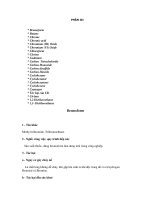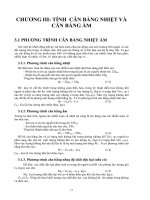PASSAGE 3
Bạn đang xem bản rút gọn của tài liệu. Xem và tải ngay bản đầy đủ của tài liệu tại đây (44.36 KB, 3 trang )
Fiberscopes are one of the most are one of the most important outcomes of he science of fiber optics.
Fibers made of glass and transparent acrylic plastic are capable of conveying light energy, and when
thousands of these fibers are combined in what is called a fiberscope, they can transmit images. The most
common fiberscopes contain about 750,000 fibers, each 0.001 centimeter, or 10 microns, in diameter. For
certain uses, the diameter of the fiber may be as small as 5 microns.
Fiberscopes have a wide range of applications. In the medical field, physicians use fiberscopes to
examine internal organs and as an aid in delicate surgeries. Miniature probes have also been developed to
view muscle fiber, skin tissue, and blood cells. Fiberscopes have also found varied uses in industry,
particularly to inspect or control operations in inaccessible areas. Bundles of fiberscopes fused together in
a solid plate, called a faceplate, are being used in the manufacture of television tubes and other cathoderay tube devices.
The most far reaching applications of fiber-optic technology are in communication. Optical fibers
carry voice messages for telephone service. The sound of the voice is electronically broken down into
thousands of pulses per second, which causes a transmitting laser to send coordinated pulses of light
through the optical fibers. At the receiving end, the light pulses are converted to electrical signals and the
voice message is reconstructed. Light-wave communication systems can handle an immensely greater
number of telephone calls and television programs than the current system, and they will form the basis
of the “electronic superhighway” expected to crisscross the nation in the near future of the information
age.
Question 1. How do optical fibers carry voice message?
A. By fusing bundles of fiberscopes into a faceplate
B. By converting electrical signals to light pulses
C. By sending coordinated electrical pulses through optical fibers
D. By using cathode-ray tube device
Question 2. The word "inaccessible" in line 10 means _______.
A. difficult to find
B. extremely small
C. hard to reach
D. impossible to climb
Question 3. It can be inferred from the passage that fiberscopes ________.
A. will play a major role in the information age
B. have more uses in industry than in medicine
C. will decrease in importance as they become more common
D. have reached the peak of their development
Question 4. Where in the passage does the author discusses the uses of miniature probes in medicine?
A. Lines 2-10
B. Lines 8-11
C. Lines 12-16
D. Lines 17-20
Question 5. The main topic of the passage is ________.
A. The birth of the “electronic superhighway”
B. How sound may be transformed into light
C. How fiberscopes have enhanced the field of medicine
D. The various applications of fiber-optic technology
Question 6. As used in line 19, the word “they” refers to _______.
A. fiberscopes
B. light-wave communication systems
C. television programs
D. telephone calls
Question 7. The word “particularly” in line 10 is closest in meaning to _______.
A. delicately
B. generally
C. specifically
D. visually
Question 8. Fiberscopes are used to do all of the following EXCEPT _______.
A. assist in delicate surgeries
B. control operations in inaccessible areas
C. transmit images
D. convert light pulses to electrical signals.
Question 9. The word "coordinated' in line 16 is closest in meaning to _______.
A. organized
B. separated
C. transformed
D. deconstructed
Question 10. The passage is most likely to be followed by a discussion of _______.
A. homes and businesses of the future
B. additional uses of fiberscopes in industry
C. the structure of fiberscopes
D. the use of fiberscopes in the electronic superhighway
ĐÁP ÁN
1-B
2-B
3-D
4-B
5-D
6-B
7-C
8-D
9-A
10-D
LỜI GIẢI CHI TIẾT
Question 1: B
thông tin trong đoạn:. The sound of the voice is electronically broken down into thousands of pulses per
second, which causes a transmitting laser to send coordinated pulses of light through the optic fibers. At
the receiving end, the light pulses are converted to electrical signals and the voice message is
reconstructed.
Question 2: B
Thông tin trong câu: . Miniature probes have also found varied uses in industry, particularly to inspect or
control operations in inaccessible areas (từ khóa là miniature: vi mơ, nhỏ)
Question 3: D
thơng tin trong câu cuối: and they will form the basis of the "electronic superhighway" expected to
crisscross the nation in the near future of the information age.
Question 4: B
thông tin trong câu: In the medical field, physicians use fiberscopes to examine internal organs and as an
aid in delicate surgeries. Miniature probes have also been developed to view muscle fiber, skin tissue, and
blood cells
Question 5: D
D: những ứng dụng đa dạng của công nghệ sợi quang
Question 6: B
Light-wave communication systems can handle an immensely greater number of telephone calls and
television programs than the current system, and they will form the basis of the “electronic
superhighway” expected to crisscross the nation in the near future of the information age.
Question 7: C
C: specifically =particularly: Cụ thể là, đặc biệt là
Question 8: D
Thông tin trong câu: At the receiving end, the light pulses are converted to electrical signals and the voice
message is reconstructed -> light pulses được chuyển thành electrical signal nhờ electronic chứ ko phải
dây quang
Question 9: A
organized = coordinated: phối hợp, tích hợp
Question 10: D
ứng dụng của sợi quang trong “siêu xa lộ điện tử’ ( có thể đọc ở cuối bài thấy nhắc đến việc này-> đoạn
văn đi sau có thể sẽ nói về điều này)
Bài dịch
Ống nội soi là một trong những kết quả quan trọng nhất của khoa học nghiên cứu về sợi quang. Sợi
thủy tinh và nhựa acrylic trong suốt có khả năng truyền năng lượng ánh sáng, và khi hàng ngàn những sợi
đó được kết hợp trong những cái được gọi là ống nội soi , chúng có thể truyền tải hình ảnh được. Các ống
nội soi phổ biến nhất chứa khoảng 750.000 sợi, mỗi sợi có đường kính 0,001 cm, hoặc 10 micron. Đối với
một vài mục đích sử dụng nhất định, đường kính của sợi có thể được làm nhỏ như 5 micron.
Ống nội soi có một loạt các ứng dụng. Trong lĩnh vực y tế, các bác sĩ sử dụng ống nội soi để kiểm tra
nội tạng và dụng cụ trợ giúp trong những ca phẫu thuật cần tỉ mỉ . các ống nội soi được phát triển để có
thể xem được sợi cơ, mô da và tế bào máu. Thăm dị vi mơ cũng đã được dùng cho nhiều mục đích sử
dụng khác nhau trong ngành cơng nghiệp, đặc biệt là kiểm tra hoặc kiểm soát sự vận hành máy móc tại
các khu vực khơng thể tiếp cận được. Các bó ống nội soi hợp nhất với nhau trong một tấm rắn, được gọi
là mặt che, được sử dụng trong sản xuất các dịng hình ảnh truyền hình và các thiết bị ống dùng tia
cathode khác.
Các ứng dụng sâu rộng nhất của công nghệ sợi quang là trong truyền thơng. sợi quang mang tin nhắn
bằng giọng nói qua dịch vụ điện thoại. Âm thanh của giọng nói được chia thành hàng ngàn xung mỗi giây
nhờ điện từ, khiến một tia laser liên lạc gửi xung phối hợp của ánh sáng qua sợi quang. Ở đầu nhận, các
xung ánh sáng được chuyển đổi thành tín hiệu điện và các tin nhắn bằng giọng nói được tái hiện lại. Hệ
thống thơng tin liên lạc quang- sóng có thể xử lý một số lượng vô cùng lớn các cuộc gọi và chương trình
truyền hình so với hệ thống hiện tại, và chúng sẽ là cơ sở của các "siêu xa lộ điện tử" dự kiến sẽ lan tỏa
khắp các quốc gia trong tương lai gần của thời đại công nghệ thông tin.









